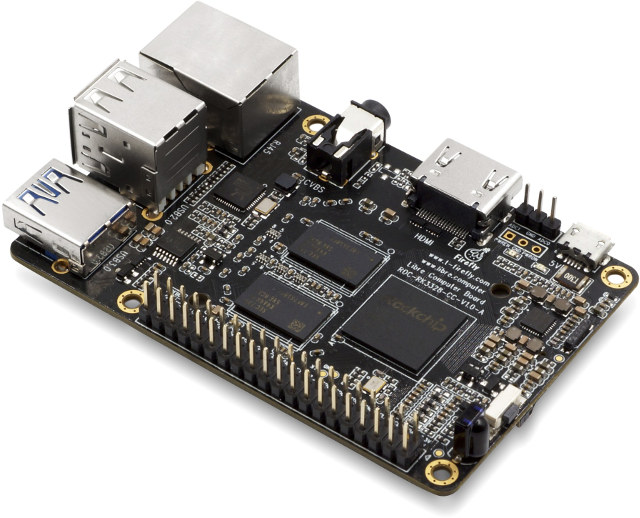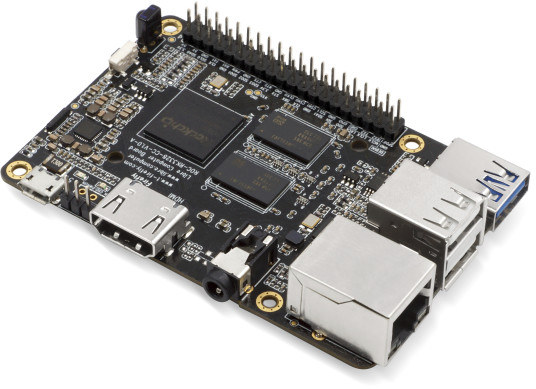After Amlogic S905X based Le Potato board, and the on-going Kickstarter campaign for Tritium Allwinner H2+/H3 boards, Libre Computer has now launched an Indiegogo campaign for their Renegade SBC (Single Board Computer) powered by Rockchip RK3328 SoC.
The board follows Raspberry Pi 3 form factor like the two previous models, and three versions of the board are offered with 1, 2 or 4GB RAM, making Renegade SBC a direct competitor to Pine64 ROCK64 board.
- SoC – Rockchip RK3328 quad core Cortex A53 processor with ARM Mali-450MP2 GPU
- System Memory – 1, 2, or 4 GB DDR4
- Storage – eMMC 5.x flash module socket (8 to 128 GB) + micro SD card slot
- Video & Audio Output – HDMI 2.0a up to 4K @ 60 Hz with HDR10 and HLG support, 3.5mm AV port (composite video + stereo audio)
- Video Codec – 4K VP9, H.265 and H.264, 1080p VC-1, MPEG-1/2/4, VP6/8
- Connectivity – Gigabit Ethernet
- USB – 2x USB 2.0 ports, 1x USB 3.0 port
- Expansion Headers
- 40-pin (mostly) Raspberry Pi compatible GPIO header with PWM, I2C, SPI, GPIOs
- 3-pin ADC Header with 2x analog inputs, GND
- Debugging – UART header pins
- Misc – IR receiver; button
- Power Supply – 5V via micro USB port
- Dimensions – 85 x 56 mm
The specifications are very close to the ones of ROCK64, but one important difference is that the Libre Computer board uses DDR4 memory instead of LPDDR3, so some 4K HDR videos may play better on the latter (TBC). However, based on the information provided in the product page, Renegade appears to be missing the 128Mbit SPI flash (mostly useful for network boot), comes with less I/O pins, and uses a micro USB port for power instead of a power barrel jack, so you’d have to make sure you use a low resistance USB cable to avoid any power issues.

The board will run Linux distributions and Android 7.1 Nougat, but images for this board are not available for download yet. Support is provided via LoveRpi forums, and the Linux source code for all Libre Computer boards will be found on Github (now only for Amlogic AFAIK).
A pledge of $35 should get you Renegade 1GB board, $50 Renegade 2GB, and $70 Renegade 4GB. The company also offers rewards with various accessories including heatsink, active cooling case, 5V/2.5A power supply, and a micro SD card (8 or 32GB). Shipping adds $7 to $10 to the US depending on the perk, and $9 to $14 to the rest of the world. Delivery is planned for January 2018. For reference, ROCK64 board sells for $24.95, $34.95 or $44.95 with respectively 1, 2 or 4 GB LPDDR3 RAM, to which you add around $12 shipping.

Jean-Luc started CNX Software in 2010 as a part-time endeavor, before quitting his job as a software engineering manager, and starting to write daily news, and reviews full time later in 2011.
Support CNX Software! Donate via cryptocurrencies, become a Patron on Patreon, or purchase goods on Amazon or Aliexpress





